Plenty of fun for those spending Seollal in Seoul
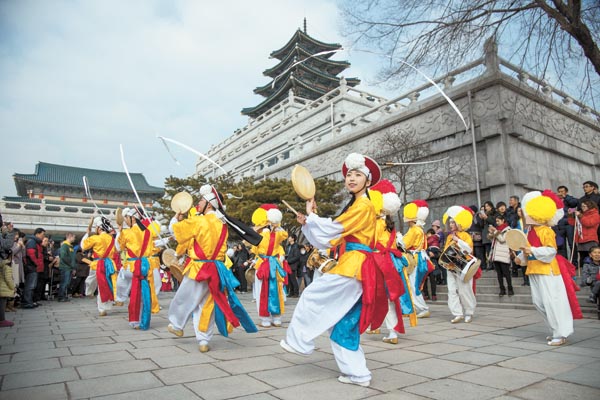
The National Folk Museum of Korea presents a performance of nongak, traditional Korean music performed by farmers. It is one of Korea’s best-known cultural performances. [NATIONAL FOLK MUSEUM OF KOREA]
Seollal is one of the biggest national holidays in Korea, with a focus on family harmony. Many people go to their hometowns to see relatives.
The most common pastimes include eating traditional foods, playing games such as yutnori - a traditional Korean game - and wearing hanbok, or traditional clothing.
The five-day holiday starts today and lasts for two days after Seollal, which falls on Monday. To help you make the long holiday special and celebrate the start of the Year of Monkey, the Korea JoongAng Daily has compiled information on a variety of events.
“Not only Koreans but also foreign tourists can enjoy Seollal,” an official of the National Folk Museum of Korea said. “Brochures are written in Chinese, English and Japanese, and interpreters are also in service.”
Festivals, exhibitions and performances have been prepared just for the holiday, and the events are not to be missed.
National Folk Museum of Korea
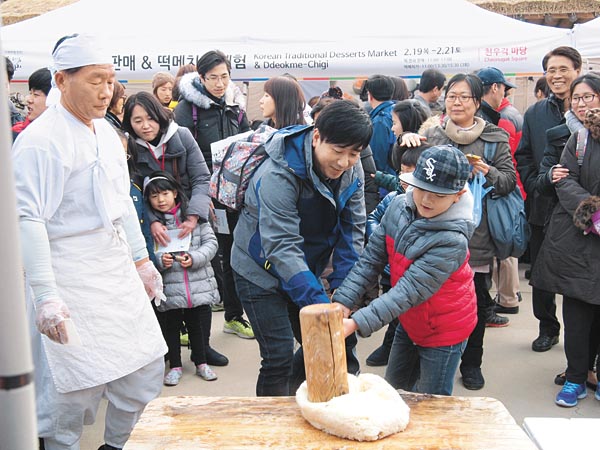
A father and son hit a mass of rice cake with a tteokme, a rice cake mallet. It is one of the events happening at the Namsangol Hanok Village during Seollal. [NAMSANGOL HANOK VILLAGE]
As 2016 is the Year of Monkey, the title of the festival is “Red Monkey Bringing Good Fortune.” The activities consist of various monkey-related games and making monkey masks, monkey trays and monkey dolls out of clay.
Most of the activities do not require reservations. If those born in the Year of Monkey come early to the folk museum, a limited number will receive a lucky bag containing yut, the sticks used to play yutnori.
“The main focus of the festival is on the monkey, as it has wisdom, emphasizes familial union and calls for luck,” a museum official said.
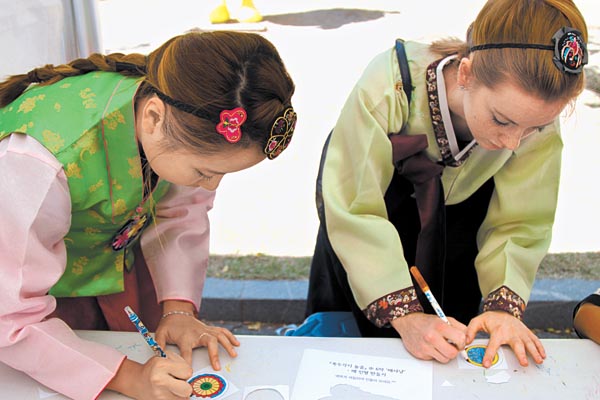
Two foreign visitors enjoy a Seollal activity. Translation service will be provided at the National Folk Museum of Korea for foreign visitors. [NATIONAL FOLK MUSEUM OF KOREA]
Special performances of art forms registered as intangible cultural assets by the government are planned for each day.
These include nongak, traditional music performed by farmers; gut, a traditional Korean shaman ritual to comfort spirits; and talchum, a traditional masked dance drama. There are also performances for children scheduled.
Visitors can also learn about how other countries, such as Uzbekistan and Indonesia, celebrate Lunar New Year.
Most activities are free of charge, but some cost between 3,000 won ($2.50) and 5,000 won.
The events run today through Wednesday from 11 a.m. to 4 p.m. or 5 p.m.
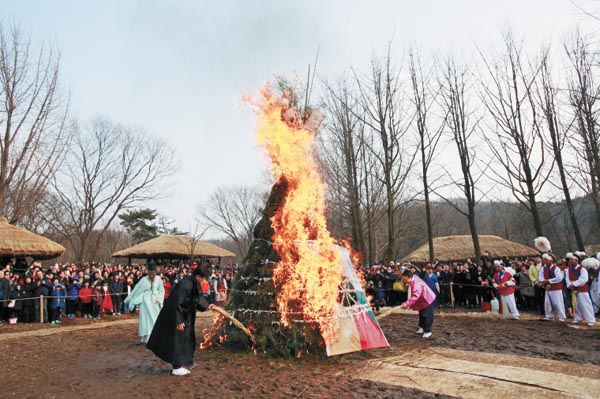
A daljip burns at the Korean Folk Village. A daljip is a bundle of straw, bamboo and pine branches. Burning daljip is a traditional ritual to wish for good luck in the new year. [KOREAN FOLK VILLAGE]
At this hanok, or traditional house, village located in Pil-dong, Jung District, central Seoul, special events are held throughout the year according to the traditional lunar calendar.
For Seollal, the village is holding events on Monday and Tuesday from 11 a.m. to 5 p.m. Visitors can experience diverse activities such as eating tteokguk, learning how ancestral rites are carried out and playing traditional games. Families can show off their strength by cooperating to pound rice cake with a tteokme, a rice cake mallet. This is done to make the rice cake, which is traditionally eaten in soup for the new year, smoother and more delicious.
Visitors can make various traditional toys such as traditional masks, or tal, kites, spinning tops and bows. These activities cost between 5,000 won and 10,000 won.
Korean Folk Village
For more than 10 days, you can enjoy diverse activities in the Korean Folk Village in Yongin, Gyeonggi. This theme park was made to show how Koreans lived during the Joseon Dynasty (1392-1910).
One of the three main activities for the Seollal holiday is burning daljip, which are large bundles of straw, bamboo and pine branches, to wish for good luck in the new year. This ritual will take place on Monday.
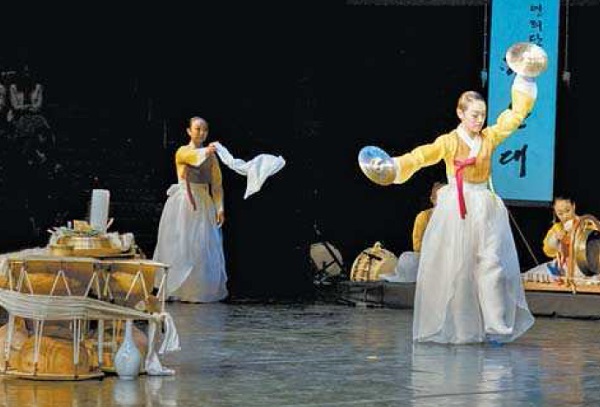
Yeonhuidan Palsandae, an all-women nongak group, is scheduled to perform on Monday at the National Museum’s Open Plaza.[YEONHUIDAN PALSANDAE]
The third is sharing tteok of luck, which uses rice cake made inside a traditional furnace.
Visitors born in the Year of Monkey, or anyone wearing hanbok, is eligible for a 50 percent discount on a day pass at the park.
Unhyeon Palace
Unhyeon Palace was the childhood home of King Gojong (1852-1919), the 26th king of the Joseon Dynasty.
The palace will host a New Year’s drum ceremony for an hour on Monday for Seollal. The performance announces that a new year has begun full of hope. The next day, a fusion performance combining samulnori, traditional Korean percussion performance, with traditional folk songs will be held.
The game of yutnori will be available for groups of eight from 3 p.m. for two hours on Monday and Tuesday. You can also find out your future with yut, a special way to tell fortunes. You can also make a wish for 2016 and create a talisman to protect your luck in the new year.
Traditional folk games will be extended to Feb. 21 for those who have to visit their hometowns outside of Seoul.
“I hope many people will enjoy Seollal with events provided at Unhyeon Palace,” said Kang Hee-eun, chief of the history and cultural heritage division of the Seoul Metropolitan Government.
Sejong Center for the Performing Arts
During Seollal, if you want to experience something totally new, the Chamber Orchestra Kremlin is slated to perform on Sunday at the Sejong Center’s M Theater.
The orchestra from Russia consisting of young players will be led by conductor Misha Rachlevsky, who is acclaimed in the field of chamber music.
The program includes pieces by Tchaikovsky, Mozart, Strauss and Bruch. The orchestra will also play Russian folk songs.
The orchestra will perform at 3 p.m. and 7 p.m. Tickets range from 30,000 won to 100,000 won.
National Museum of Korea
On Monday, a special performance will be held at the National Museum’s Open Plaza.
Yeonhuidan Palsandae, an all-female group of nongak performances, will present “Somunmanboklae,” which means fortune comes to a merry home.
Palsandae comes from the word Sandae, which was the name of a famous street festival during the Joseon Dynasty. The group added pal, meaning eight, the number representing proficiency in traditional thinking.
At the 2012 Yeosu Expo, Yeonhuidan Palsandae performed four times a day on average for 93 days. Due to their immense popularity, the group started to perform in the United Kingdom, Japan, Italy and other countries.
This extraordinary group will hold a special performance to celebrate Seollal.
The performance starts at 3 p.m. and lasts for an hour. Admission is free in charge.
MMCA
For Seollal, the National Museum of Modern and Contemporary Art (MMCA) will be open free of charge through Wednesday. It will be a good opportunity to enjoy various exhibitions at the main branch in Gwacheon, Gyeonggi; the main Seoul branch in Jongno District, central Seoul; and the Deoksu Palace branch in Jung District, central Seoul.
Moreover, at the Gwacheon and Seoul branches, there will be special Seollal events to welcome visitors.
The Gwacheon branch will hold a promotional event called “We Are Going to the Museum for Seollal.” To participate, visitors take a photo to prove they actually visited the museum and then post it to social media with the caption “National Museum of Modern and Contemporary Art Gwacheon Branch 30 years.” Every day, 100 people will receive pens specially designed in collaboration with Monami, a famous Korean ballpoint pen company.
The ongoing exhibitions at the Gwacheon branch are “Retrospective” by Korean photographer Yook Myung-shim, “Cho Sung-mook in Taste of Style” and “Donated Works of Oh Seung-woo.”
The Seoul branch has planned an event called “The Lunar Year Starting with Art, Happy Lucky Monkey New Year.”
People who visit during the holiday period will get a card depicting a monkey and peach called “Yuhuido 1.” Visitors who write a letter and put it in the mailbox of the museum will get a New Year’s card sent to their home.
Don’t forget to try your luck winning a free coffee coupon to be used at the cafe of the Seoul branch. A total of 2,000 visitors every day will get a lucky coupon.
Exhibitions at the Seoul branch include “Peripheral Thinking” by William Kentridge and “A Dazzling Despair” by Philippe Garrel.
The Deoksu Palace branch is also running a special exhibition.
“MMCA Collection Highlights Part II: Reading Paintings” displays modern Korean paintings from the 1900s to ’60s. It reflects the trends of traditional-style Korean paintings of that period.
BY KIM HYANG-MIN [kim.hyangmin@joongang.co.kr]










with the Korea JoongAng Daily
To write comments, please log in to one of the accounts.
Standards Board Policy (0/250자)